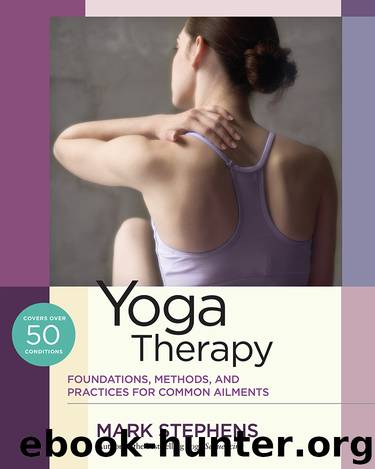Yoga Therapy by Mark Stephens

Author:Mark Stephens
Language: eng
Format: epub
ISBN: 9781623171070
Publisher: North Atlantic Books
Published: 2017-10-01T04:00:00+00:00
The Essential Qualities of Asana Practice
Although there are potentially infinite qualities of asanas as they come to be experienced by the unique persons doing them, we can highlight some qualities that are essential in cultivating yoga practice in a way that makes it more accessible, sustainable, and deeply transformational.
Sthira Sukham Asanam
Among the most important elements of asana practice is the idea that it is a personal practice, not a comparative or a competitive practice, despite some people doing their best to make it so.17 Exploring with this basic sensibility, the practice will be more safe, sustainable, and transformational. It’s a sensibility—a basic yogic value—that reflects the sole comment on asana found in the Yoga Sutra of Patanjali: sthira sukham asanam—meaning steadiness, ease, and presence of mind (the latter, from the root word as, meaning “to be,” or “to be present,” which I interpret to mean to be here now, fully attuned to one’s immediate experience).
It is helpful to relate to these as qualities we are always cultivating in the practice. Do note that Patanjali is not describing anything even closely approximating the sort of postural practices that began evolving several hundred years later and eventually became Hatha yoga, which has evolved more in the past seventy-five years than in the previous thousand. Nonetheless, we find the sensibilities of classical yoga brought forward in the earliest verified writing on Hatha practice, the mid-fourteenth-century Hatha Yoga Pradipika, where Swami Swatmarama tells the yogi to have “enthusiasm, perseverance, discrimination, unshakable faith, and courage” to “bring success to yoga” and “get steadiness of body and mind”; later, Swatmarama mentions “being free of fatigue in practicing asana,” suggesting the balance of steadiness and ease earlier emphasized by Patanjali.18
Exploring this, let’s say for a moment that we’re starting a practice standing at the front of the mat (bearing in mind here that the same concepts, qualities, and sensibilities are ideally cultivated regardless of one’s initial postural position—sitting, lying supine, and so on). This standing posture might be Tadasana (Mountain Pose). In it, we are opening to being as steady, at ease, and present as we can be and thereby more naturally open to a deepening sense of balance and equanimity that is well expressed with another Sanskrit term: samasthihi (literally, “equal standing”). For some clients, this simple position is somewhat challenging, especially if held for several minutes or if a student has a condition such as general postural misalignment, advanced pregnancy, multiple sclerosis, leg length discrepancy, or basic weakness. With practice, it’s likely to become easier to find and sustain a sense of samasthihi in this position, especially with proper alignment and energetic actions. If all one did was continue to stand and move into deeper equanimity (or sit or lie supine), this might become more of a meditation practice. But here we are presently focusing on asana, the postural practices that are best explored with conscious breathing and presence of mind (the reciprocal effects of which are further essential aspects of asana practice) and contain the potential for various qualities of self-transformation and healing.
Download
This site does not store any files on its server. We only index and link to content provided by other sites. Please contact the content providers to delete copyright contents if any and email us, we'll remove relevant links or contents immediately.
Bodyweight Strength Training by Jay Cardiello(7259)
Tools of Titans by Timothy Ferriss(7079)
Born to Run: by Christopher McDougall(6359)
Inner Engineering: A Yogi's Guide to Joy by Sadhguru(6001)
Asking the Right Questions: A Guide to Critical Thinking by M. Neil Browne & Stuart M. Keeley(4703)
The Fat Loss Plan by Joe Wicks(4310)
Bodyweight Strength Training Anatomy by Bret Contreras(4127)
Yoga Anatomy by Kaminoff Leslie(3765)
Science and Development of Muscle Hypertrophy by Brad Schoenfeld(3642)
Dynamic Alignment Through Imagery by Eric Franklin(3567)
The Four-Pack Revolution by Chael Sonnen & Ryan Parsons(3531)
ACSM's Complete Guide to Fitness & Health by ACSM(3525)
Yoga Anatomy by Leslie Kaminoff & Amy Matthews(3460)
Bodyweight Strength Training: 12 Weeks to Build Muscle and Burn Fat by Jay Cardiello(3432)
The Ultimate Bodybuilding Cookbook by Kendall Lou Schmidt(3396)
Exercise Technique Manual for Resistance Training by National Strength & Conditioning Association(3380)
Nutrition for Sport, Exercise, and Health by Spano Marie & Kruskall Laura & Thomas D. Travis(3298)
Nutrition for Sport, Exercise, and Health by Marie Spano & Laura Kruskall & D. Travis Thomas(3288)
Yoga Therapy by Mark Stephens(3280)
